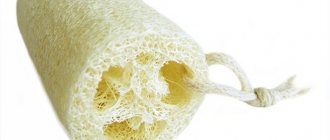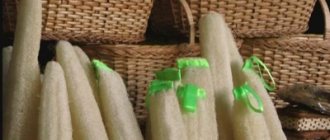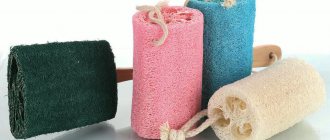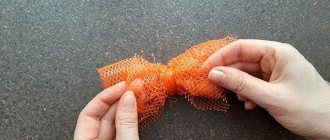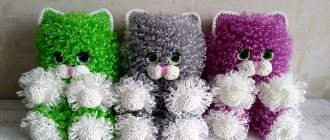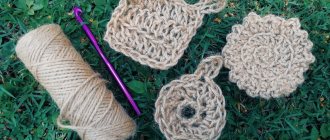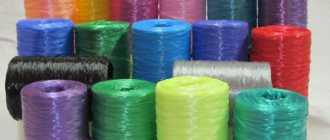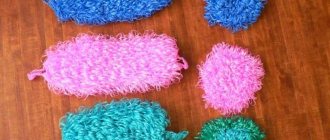Today everything natural is in fashion. Natural food, natural cosmetics, clothing made from natural fibers. The bathhouse is generally a stronghold of naturalness, starting from the logs and ending with the broom. Naturally, in the realm of environmentally friendly items there should be no exceptions, even in such little things as washcloths. No synthetics. Why is she in the bathhouse if there is such a wonderful product in the world as a loofah washcloth? Our story today is about her.
Tips for growing luffa
- Germination can take up to 14 days, so patience is required.
- Before planting, soak the seeds overnight in a glass of water to speed up germination.
- Plant 3 or 4 seeds a few centimeters apart in a group, pushing them 1 centimeter into the soil.
- Create spatial groups at a distance of 15 to 20 centimeters
- Once the plants reach 30 cm in height, thin out the smaller seedlings from ground level, leaving only the strongest to grow, one or two per group.
Advantages and disadvantages of natural washcloths
Manufacturers offer us a large selection of a wide variety of natural washcloths, which differ in shape, size, material density, and structure. Some people make eco-scrubbers with their own hands. I, too, recently had this desire: I have jute at home, and I know how to knit)). But so far this has not come to fruition.
Why should you choose natural washcloths for your hygiene, what advantages do they have over synthetic ones:
- Act as an antiseptic
- Massage the skin, increase its tone
- Improve blood circulation
- Cleanses pores
- Do not cause allergies
- Freely pass air
- Smell good
- Pleasant to the touch
- Environmentally friendly: decomposes when disposed of
Eco-scrubbers, when used and cared for correctly, will help you say goodbye to visible skin problems and improve the appearance of your body. They will help you cheer up in the early morning and relax after a hard day.
At the same time, such products are difficult to maintain and in some respects are inferior to their artificial counterparts, namely:
- They don’t release water well and take a long time to dry.
- Harmful microorganisms quickly develop in them
- Short-lived (average service life is two to three months)
- Most materials are hard to the touch
- Most often they foam poorly
- More expensive than synthetic analogues
Such a list of disadvantages can be intimidating, but in fact the advantages outweigh, don’t they?
Nuances of operation
The use of a luffa sponge involves the following points:
- the frequency of use varies depending on the characteristics of the skin, and the product can be used no more than 2 times a week;
- not recommended for use on irritated skin or the presence of wounds or burns;
- Before use, a luffa sponge should be soaked for 3-5 minutes in warm water;
- After use, the product is well dried and stored in a cool, dry place away from direct rays of the sun and heating appliances;
- under appropriate operating and storage conditions, the service life of a washcloth made from natural raw materials is 2-3 months.
It is noteworthy that a specimen that has ripened on the plant’s vine and is distinguished by its rigid structure will last slightly longer.
Good afternoon, dear friends and guests of the site “I am a villager”! Today we’ll talk about the interesting loofah plant and its use in our daily lives. My interest in this plant arose not long ago, and this was due to the choice of a high-quality and environmentally friendly washcloth.
By the way, the word loofah should be written with two f, but people speak and write it with one, let it be in the folk way.
After looking through a bunch of different washcloths in the store, I decided on a loofah washcloth.
The seller turned out to be very sociable, and we talked for a long time about the types and forms of washcloths, we came to the conclusion that loofah, a natural product, and a washcloth made from it is also natural and brings benefits and purity to our body.
I was wondering if this is a plant, it means I can grow it myself and try to make my own natural washcloths.
Do you know that it is recommended to replace washcloths every 2-3 months, for those who like to go to the bathhouse, but in the shower it is advisable to renew the washcloth every month. Then you will have clean and silky skin without inflammation and irritation.
I found a lot of information on this topic and I found it interesting, I want to share it with you, my dear readers. Suddenly you, too, want to grow this unusual plant. Maybe some advice will come in handy when choosing washcloths. Let's get started.
Plant care
Many people are interested in such a plant as luffa. How to make a washcloth? To make a bath accessory, you first need to grow high-quality fruits.
Luffa leaves absorb a huge amount of moisture, so you need to carefully ensure that the soil does not dry out and the plant has constant access to the necessary nutrients. Water for irrigation must be warm, otherwise the luffa may die. Experienced gardeners also recommend spraying the vine itself once every two weeks or using a sprinkler.
As soon as the first mature ovaries are formed, you need to select 3-5 of the strongest ones, the rest need to be plucked out. In order for nutrients to reach the fruit, it is better to remove the side branches, the same applies to excess green mass.
Luffa, like any other plant, requires a large amount of oxygen, so the soil needs to be loosened three times a season, given the shallow root system, this procedure must be carried out very carefully.
Pollination - initially only female flowers are formed, male flowers begin to appear only after 10-12 days. Given the nature of the plant, it is almost impossible to pollinate it with the help of insects; the most reliable way is to use the manual method. It will be possible to find out whether the work was carried out successfully or not in a few days; the pollinated ovaries increase significantly in size.
Beneficial features
Loofah seeds contain a huge amount of edible oil and protein. Luffa is included in many cosmetic products.
There are also vegetable and technical varieties of this plant. They differ in the quality of the oil obtained and in the scope of its use. Technical varieties are used to prepare loofah, and the oil obtained from the seeds is included in various face masks and other cosmetics. Food grades are used in cooking.
Not only the fruits and seeds of the plant, but also their green part have beneficial properties. For example, the juice from luffa stems in Japan is widely used to create lipstick or used as a lotion to cleanse the skin.
Before World War II, luffa (loofah) was used for industrial production. Due to its light and porous texture, it was used in various filters and diesel parts.
Also, due to good sound insulation and high strength, the fruits of the plant were used as an inner layer in the manufacture of steel helmets and automotive equipment for the US Army.
How to make a loofah from luffa fruit
In order to turn a huge fruit into a wonderful bath attribute, you need to know some subtleties.
Only from ripe fruits can you make a sponge, that is, the pulp inside must dry. The color of the fruit will help you find out the exact time; when it turns brown, the time has come! And, of course, don’t forget about the dry tip at the end.
If the fruits have not had time to ripen (for example, you are unlucky with the weather), then they can be collected green and dried in a warm, dry room.
In order to obtain the skeleton of a loofah without much difficulty, you must first work with the fruit. Some summer residents recommend soaking the luffa skin for several days in water to soften it. But, there is a more practical way:
Dip the dry fruit in boiling water for 10-15 minutes, then cool and the skin is easy to peel. Once you get your future loofah, hold the fibers up to the light. Surprisingly many seeds, right!?
You also need to get rid of the seeds; this can be done in two ways - picking them out or putting a washcloth in water. The seeds should come out of the fibers on their own.
Once you have a real luffa sponge in your hands, rinse it in a soapy solution, then in clean water and let it dry in free air. Now it's time for your imagination! You can cover the luffa with soft fabric, cut it into convenient pieces, make double-sided washcloths - in general, whatever you want!
Making loofah sponges
The very first advantage of this plant is that its ripe fruits make good washcloths, natural and strong. Medicine recommends the use of such washcloths. Using this washcloth, you will thoroughly cleanse the skin of old dead cells, it works like a good scrub, you will get an excellent muscle massage and clean, ruddy skin, and will reduce the appearance of “orange peel.”
Loofah fruits ripen late, in our area it will be in October; we remove the fruits before frost and place them in a well-ventilated, warm room to dry.
This process lasts several days and sometimes weeks. You can check whether the fruit is dry or not dry by taking it and shaking it; if the seeds inside roll and rustle, the fruit is ready for making a washcloth.
We soak the dried loofah fruit for several hours, it is recommended to boil water and let the fruits go there, boil for 10 minutes, this will make them easier to peel off.
Another tip, if you want a hard sponge, wait until the fruit is ripe, and if you want a gentle and soft sponge, remove the fruits when they are not ripe and put them to dry.
We peel the dried fruits from the skin, remove the remaining pulp and seeds, use an iron brush for this. Trim the fruit on both sides.
Wash in soapy water several times and dry. The environmentally friendly washcloth is ready!
And now you can dream up. The blank can be cut into any size, handles can be tied on, a massage mitt can be modeled, slippers can be made, you can even come up with different crafts. You can grow this amazing loofah fruit and make your own washcloths.
Before you use it, soak it in hot water for 2-3 minutes, you can rub it.
Despite its naturalness and excellent effect, it is advised not to use a loofah washcloth more than 2 times a week, especially for those with sensitive skin. Everything is good in moderation, use body cream after using a loofah washcloth.
After use, wash the washcloth well and dry it.
Making loofah sponges is a good way to earn money; you can grow several bushes - vines, harvest and make a lot of natural sponges. Agree with stores and sell. From 20 loofah bushes, with good care and proper placement, you can prepare up to 800 loofahs of different sizes.
Loofah washcloths are expensive, but the profit will be significant. Having gained experience, you can expand your production of washcloths and provide them to the entire area. This is a good cash addition to your budget.
Soft washcloth: Synthetic or natural
Sponges, brushes with and without handles, tapes, massage mittens, mittens, silicone combos designed for delicate massage, peeling, bathing - the types of washcloths are amazing. To solve a complex problem with many unknowns, you need to figure out what kind of soft washcloths there are.
Soft and gentle synthetic washcloths have amazing massage properties, they hold well and form foam, they can be used daily. There are several types of synthetic hygiene products:
- Foam sponges: form foam well, dry quickly, but do not exfoliate dead skin cells of the epidermis well and are not able to provide high-quality cleansing of the skin due to their softness. A big plus is the huge selection of similar accessories in colors and sizes - creating an interesting interior in the bathroom is not difficult.
- Foamed viscose, a relatively inexpensive hygiene item, is rigid and fragile, but at the same time retains its washing properties in forming foam and cleansing the body.
- Polyester is a material for a bath accessory that can hardly be called ideal for hygiene procedures. Chemical dyes, which are added to give a beautiful color, can cause allergies and irritation in people with sensitive skin or in children, so their scope of use is very limited.
- Nylon “roses” are a good choice for those who value durability, aesthetics, and low cost of bath accessories. “Roses” wash the skin well, hold foam, dry quickly, are durable and can replace natural washcloths in certain circumstances, since they can be used every day.
What is luffa
Luffa is an annual plant from the genus of herbaceous vines. It belongs to the pumpkin family, although in appearance it is very similar to a huge cucumber!
Among the people, luffa received a funny nickname - mad cucumber. The size of the fruit can reach up to 50-70 cm, weight from two to three kilograms, and the vine itself has a length of 3 to 6 meters. When dried, the weight of the fruit decreases significantly.
Luffa prefers tropical and subtropical climates, but it also grows in warm regions. Many amateur summer residents successfully cultivate and grow luffa. The plant is whimsical and has its own “requests”. With proper care, attention and care, as well as good climatic conditions on fertile soil, you can get more than three fruits from one bush!
Exotic luffa: features of a guest from hot countries
Luffa, a member of the Cucurbitaceae family, is an annual plant. The culture is native to the tropical and subtropical regions of Asia and Africa. As a herbaceous liana, luffa reaches a length of up to 5 m during the growing season. In its natural growth area, it bears fruit abundantly, and the number of fruits on creeping stems varies between 10-30 pieces per bush. The size of the fruit is also impressive and is about 70 cm in length.
The fruits of the milk-ripe culture are edible until they acquire a characteristic mealy structure and become coarse. Young shoots of the plant are in demand in cosmetology, as they contain a number of useful substances. Luffa, as a fast-growing representative of the flora with a spectacular appearance, is suitable for shading garden gazebos and decorating hedges. From the ripened fruits of the plant, natural sponges are obtained of excellent quality, and this is the key advantage of the exotic culture.
What is unique about the luffa sponge and the advantages of its use:
- absolutely hypoallergenic product;
- promotes gentle cleansing of the skin;
- easily removes the stratum corneum of the epidermis;
- helps counteract inflammatory processes on the skin;
- provides prevention of various dermatological diseases by increasing the activity of the subcutaneous layers;
- promotes regeneration of the epidermis.
In addition, the use of a luffa washcloth is accompanied by a scrub effect and gives the feeling of a delicate superficial massage.
How to choose a place for a luffa?
Before planting a luffa, you need to choose the right place in which the plant will feel as comfortable as possible:
- Luffa (loofah) does not tolerate strong winds.
- Loves sunlight.
- The plant can be planted both in a greenhouse and in open ground.
- Before planting, you need to take care of the support; it must be strong and strong, because the plant grows very quickly and gains weight. An example would be a trellis, stretched twine, or even a metal mesh fence.
Transplantation into open ground
After the issue with the location has been resolved, it is necessary to plant the plants themselves. If the luffa is placed in a greenhouse, then the optimal time will be the second half of May, and if open ground is chosen as a permanent place of growth, then all work should be postponed until the beginning of June.
Before planting, you need to prepare holes, the depth and width of which will be 30 centimeters. The distance between plants should be at least one meter.
In order for the luffa (loofah) to take root as best as possible in a new place, the soil must be fertilized:
- You need to pour half a bucket of humus into the bottom and add 2 tablespoons of potassium sulfate there.
- Or you can use half a glass of ash per plant.
The luffa needs to be deepened to the cotyledon leaves, then the roots are carefully dug in; it is very important not to damage them during planting.
Fertilizing
You can fertilize the plant using the following substances:
- Ammonium nitrate is used during planting, second and third loosening.
- The mullein solution must be mixed with water in a ratio of 1 to 10. Fertilizing is done during the period of ovary formation.
- Complex fertilizer - you can use 1 tablespoon of nitrophoska diluted in a bucket of water. This procedure is carried out in the middle of the growing season.
- Superphosphate extract - 1 tablespoon of the substance is diluted in a bucket of water. This feeding promotes the ripening of seeds and the best ripening of the fruit.
Growing seedlings
Many summer residents are wondering how to plant and grow luffa (loofah). The answer lies in the biological characteristics of this plant. It has a fairly long growing season, so the process usually begins with germination of seedlings.
- Since luffa seeds are very hard and covered with a thick shell, they need to be prepared for planting. To do this, about a week before work, they need to be placed in a very warm place, with an air temperature of at least 40 degrees.
- Then they need to be soaked in aloe juice for 20-30 minutes.
- You need to start growing seedlings in early April so that the fruits have time to ripen before the onset of winter cold.
- The soil must be nutritious and loose, in order to avoid the occurrence of bacterial diseases, it should be disinfected.
- The first shoots should appear 5-6 days after sowing.
- In order for the luffa (loofah) to receive as many nutrients as possible, when growing seedlings it needs to be watered twice with mullein diluted in water in a ratio of one to ten.
How to care and store
Scientists have proven that natural products such as loofah sponges are an ideal habitat for various pathogenic microorganisms. Therefore, after use, you must rinse it and let it dry completely. But no matter how much you want it, even with careful and proper care, after six months it is best to replace the sponge with a new one.
If you want to use a washcloth for as long as possible, then it is worth preventing the occurrence of germs in it. To do this, you need to pour boiling water over the sponge after and before each use. If the washcloth is in your bathhouse, it will dry by itself, since the temperature in the room is always high and there will be no problems with drying.
How to use a luffa sponge?
- Cylindrical luffa - this is the subspecies suitable for making loofahs. The length of the fruits can reach 70 centimeters, becoming slightly pointed towards the stalk. They are distinguished by thin skin, which is easy to separate, and delicate white pulp. According to the method of preparation, it is no different from sharp-ribbed luffa.
- Luffa (loofah) does not tolerate strong winds.
- Loves sunlight.
- The plant can be planted both in a greenhouse and in open ground.
- Before planting, you need to take care of the support; it must be strong and strong, because the plant grows very quickly and gains weight. An example would be a trellis, stretched twine, or even a metal mesh fence.
To prepare the sponge for use, you need to wash it in soapy water and dry it naturally by hanging it in a sunny area or placing it on a window.
After each use, the washcloth must be thoroughly rinsed and dried.
Use of luffa in medicine
Many countries in Asia and the East widely use luffa in folk medicine. A decoction of the roots and green parts of the plant is an excellent remedy for stopping internal bleeding; it is also used to treat sinuses.
Many cosmetologists recommend using luffa with homemade soap. Melted soap is poured into the holes that form after peeling the fruit from seeds and pulp and the resulting sponge is used as a scrub. This cosmetic product will perfectly cleanse the skin and stimulate blood circulation in small vessels.
One of the most beneficial fruits for the skin comes from a plant called luffa. The washcloth, the photo of which can be seen above, is an environmentally friendly product. With enough effort, you can grow it in your garden. In addition, the vines on which the fruits are formed have an unusual appearance, so they are often used in landscape design.
